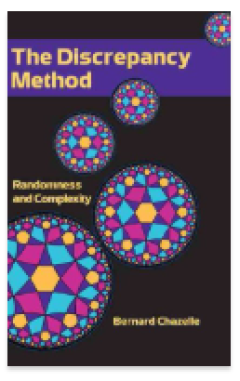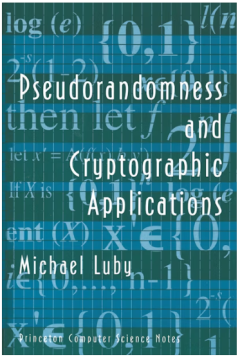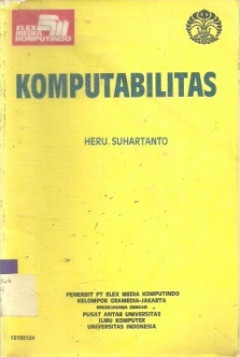Filter by

The discrepancy method : randomness and complexity
- Edition
- Cet. I
- ISBN/ISSN
- 9780521770934
- Collation
- xvii, 463 hal. : ilus ; 24 cm.
- Series Title
- -
- Call Number
- 512.7 CHA d
- Edition
- Cet. I
- ISBN/ISSN
- 9780521770934
- Collation
- xvii, 463 hal. : ilus ; 24 cm.
- Series Title
- -
- Call Number
- 512.7 CHA d

Pseudorandomness and cryptographic applications
A pseudorandom generator is an easy-to-compute function that stretches a short random string into a much longer string that “looks” just like a random string to any efficient adversary. One immediate application of a pseudorandom generator is the construction of a private key cryptosystem that is secure against chosen plaintext attack. There do not seem to be natural examples of functi…
- Edition
- -
- ISBN/ISSN
- 9780691025469
- Collation
- xvi, 234 hal : 23 cm
- Series Title
- -
- Call Number
- 005.82 LUB p

Komputabilitas
Daftar isi: 1. EPIMENIDES,GODEL,RUSSEL,DAN CANTOR 1.1 Epimenides 1.2 Godel 1.3 Russel 1.4 Cantor 2. TEORI INFORMAL PADA PUNGSI KOMPUTABEL 2.1 Fungsi fungsi 2.2 String 2.3 Fungsi komputabel,himpunan listabel dan himpunan decidabel 2.4 Fungsi universal dan himpinan tak decidabel 2.5 Teorema rice 3. FUNGSI FUNGSI REKURSIF PRIMITIF 3.1 Rekursi primitif 3.2 Minimasi dan kuantifay…
- Edition
- --
- ISBN/ISSN
- 9795373250
- Collation
- x, 156 hlm.; ilus.; 21 cm
- Series Title
- --
- Call Number
- 004.0151 HER k

Introduction to the theory of computation
PART 1: AUTOMATA AND LANGUAGES. 1. Regular Languages. 2. Context-Free Languages. PART 2: COMPUTABILITY THEORY. 3. The Church-Turing Thesis. 4. Decidability. 5. Reducibility. 6. Advanced Topics in Computability Theory. PART 3: COMPLEXITY THEORY. 7. Time Complexity. 8. Space Complexity. 9. Intractability. 10. Advanced Topics in Complexity Theory.
- Edition
- 3rd Edition ( International Edition )
- ISBN/ISSN
- 9781133187813
- Collation
- xxii, 457 hal.; ilus.; 24cm.
- Series Title
- --
- Call Number
- 004.0151 SIP i

Algorithmic randomness and complexity
This book is concerned with the theory of computability and complexity over the real numbers. This theory was initiated by Turing, Grzegorczyk, Lacombe, Banach and Mazur and has seen rapid growth in recent years. br Computability and complexity theory are two central areas of research in theoretical computer science. Until recently, most work in these areas concentrated on problems over discret…
- Edition
- -
- ISBN/ISSN
- 9780387955674
- Collation
- xxviii, 854 hlm.; 26 cm.
- Series Title
- -
- Call Number
- 511.3 DOW a

Complexity and cryptography : an introduction
Contents: 1. Basics of cryptography; 2. Complexity theory; 3. Non-deterministic computation; 4. Probabilistic computation; 5. Symmetric cryptosystems; 6. One-way functions; 7. Public key cryptography; 8. Digital signatures; 9. Key establishment protocols; 10. Secure encryption; 11. Identification schemes; Appendix 1; Appendix 2; Appendix 3; Appendix 4; Appendix …
- Edition
- -
- ISBN/ISSN
- 5216177715
- Collation
- xii, 292 hlm.; 23 cm.
- Series Title
- -
- Call Number
- 005.82 TAL c

Complexity and cryptography: an introduction
Table of Contents: 1. Basics of cryptography; 2. Complexity theory; 3. Non-deterministic computation; 4. Probabilistic computation; 5. Symmetric cryptosystems; 6. One-way functions; 7. Public key cryptography; 8. Digital signatures; 9. Key establishment protocols; 10. Secure encryption; 11. Identification schemes; Appendix 1; Appendix 2; Appendix 3; Appendix 4; Appendix 5; Appe…
- Edition
- null
- ISBN/ISSN
- 9780521617710
- Collation
- xii, 292 hlm. : ilus. ; 24 cm
- Series Title
- --
- Call Number
- 005.82 TAL c
 Computer Science, Information & General Works
Computer Science, Information & General Works  Philosophy & Psychology
Philosophy & Psychology  Religion
Religion  Social Sciences
Social Sciences  Language
Language  Pure Science
Pure Science  Applied Sciences
Applied Sciences  Art & Recreation
Art & Recreation  Literature
Literature  History & Geography
History & Geography